This is the ultimate first timer’s travel guide for preparing a vacation to Tonto Natural Bridge, Arizona.
Want a way to beat the Phoenix heat while experiencing a truly wondrous natural phenomenon just 90 minutes outside of the Valley of the Sun?
Look no further than Tonto Natural Bridge! Just 10 miles north of Payson, Arizona, and part of the Mogollon Rim (pronounced “muggy-own”) region, this natural wonder is protected by Arizona State Parks and Trails, and offers a fast and easy way to commune with nature in a truly unique natural setting.
In this comprehensive guide, we will give advice on the top things to do at Tonto Natural Bridge State Park, as well as great tips to make your trip more magical.
Ultimate Travel Guide to Tonto Natural Bridge
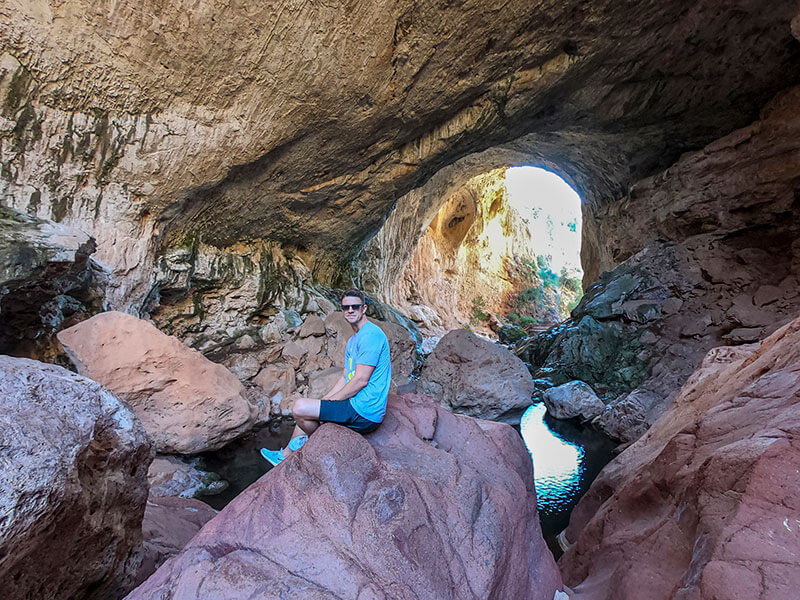
What This Guide Covers
You can read every single Tonto Natural Bridge tip here (highly recommended) or use the navigation links here to skip to the tips that are most valuable to you.
- Top 10 Things to Do at Tonto Natural Bridge
- Map of Tonto Natural Bridge State Park
- Tips for Visiting Tonto Natural Bridge
- Facts and History about Tonto Natural Bridge
- Weather at Tonto Natural Bridge
- Tonto Natural Bridge Packing List
- Estimated Cost of Tonto Natural Bridge
Watch the Tonto Natural Bridge Highlight Reel
Take a sneak peek with us to the Tonto Natural Bridge State Park:
Top 10 Things to do at the Tonto Natural Bridge
1. Hike to Tonto Natural Bridge
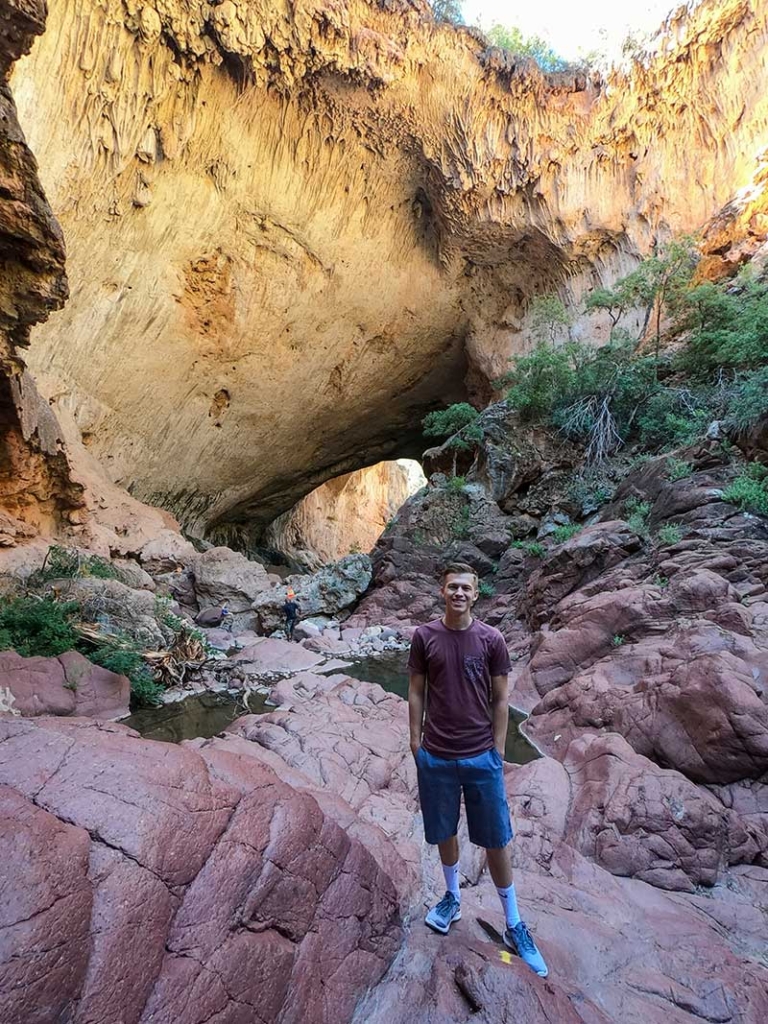
One of the best aspects of the Tonto Natural Bridge State Park is that the hiking trails are neither too intense nor too long. The longest hike is only a half mile and can easily be covered in an hour and a half max if you take the time to stop along the rocky stream and admire what is all around you.
When you make it down to Pine Creek (the creek running through the natural bridge) it is easy to see the massive tunnel that runs through the rock, making up the natural bridge. Hiking towards it will take you past some small waterfalls and up and down smooth rocks.
TIP
Look for the arrows on the rocks, they mark the easiest path and are easy to miss if you aren’t looking for them.If you climb through the tunnel past the halfway point, you will find yourself getting sprinkled on by water falling from the roof of the cavern. It can be nice and refreshing if you came in from the hot outside, or it can be mildly annoying, getting you wet and making the rocks even slipperier.
Whether you continue through to the other side of the bridge or turn back the way you came, it doesn’t matter. The gradually changing colors of the rock under the cave contrasting with the pools of water creates a unique sight, especially in hot and dry Arizona.
Disclaimer: Throughout the year, different hiking trails may be closed for renovation. When you enter the park, the park ranger will tell you if anything is closed.
2. Take a Picnic
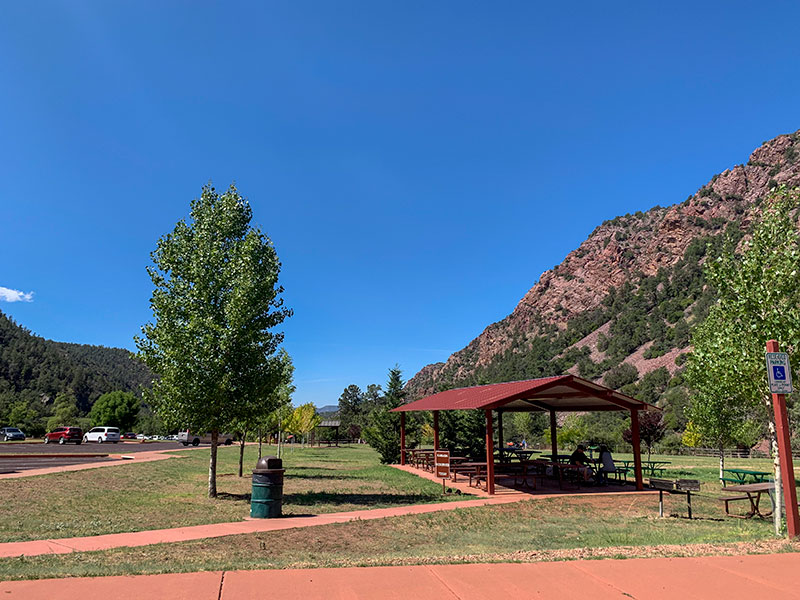
The many hikes around the Tonto Natural Bridge have stunning views of the naturally made rock formations and Pine Creek. After a few hours of hiking, exploring, and swimming, a picnic is just what you need to tie the whole experience together and enjoy the scenery.
Pack in some light or previously prepared food with you on your hike and find a large rock to enjoy your meal on.
TIP
Don’t forget to bring sufficient water! It gets warm during the summer and it’s easy to run out of water without realizing it.3. Look for Wildlife
Keep your eyes peeled for wildlife. Being a state park, the animals and plants here are some of the best protected and cared for in the entire region.
If you see something scurry across the road or trail that looks suspiciously like a small monkey, you may have just seen the ring-tailed cat. It’s long ringed tail reminds many people of a lemur, but its body looks like that of a kitten, even when they’re full grown.
Alligator lizards are reptiles with very long tails that make them look like snakes when they run through the brush. These lizards are pretty harmless to humans, but if they latch onto something with their jaw, they won’t let go. Hence the name alligator lizard.
Javelinas and elk call this park their home as well, although they are more elusive than these others.
If you are like me, you will be surprised at how friendly the fauna are along the hike, so be on the lookout!
4. Rent the Goodfellow Lawn and Have a BBQ
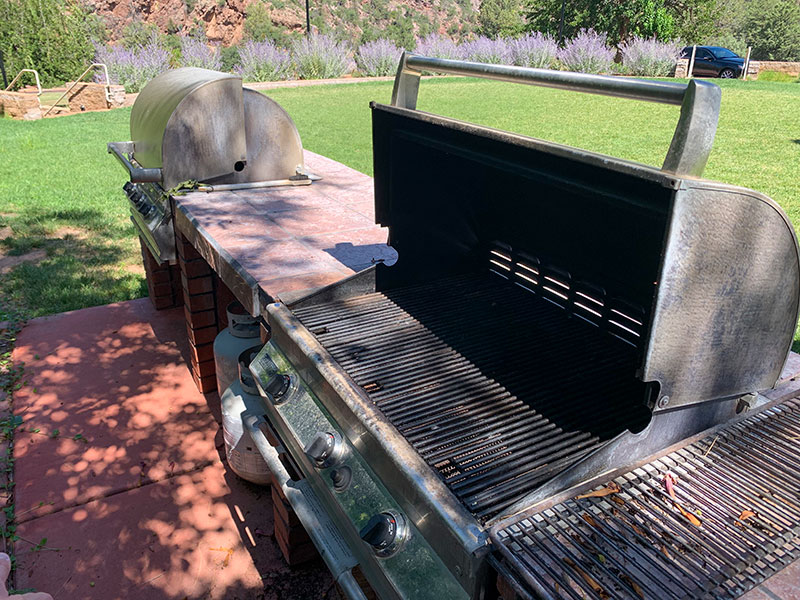
After getting your fill of hiking and exploring the natural bridge and surrounding area, relax with your group on the well-kept lawn and enjoy conversation in between bites of a freshly grilled burger. Sounds like a dream come true.
Behind the Tonto Natural Bridge Lodge there is a grassy area with light posts and fixed grills. This is the Goodfellow Lawn. Offering some of the best views in the Mogollon Rim, it is the perfect place for a family gathering or party after a day of hiking and swimming.
The price of renting the lawn out for the whole day is $40 with propane included in the price. This can be done from the State Parks office or by calling the number on the website.
5. Check out Payson, Arizona
Visiting Tonto Natural Bridge on your day off? Make a day trip out of your visit and check out Payson as well. At 5000 feet elevation, it is a great place to escape the heat of the valley and experience the pine tree forests of Arizona’s Mogollon Rim.
Payson is a small town with a charming alpine atmosphere. Buildings that look like log cabins are still common here and provide a rustic, authentic feel to the town.
Enjoy the casino, visit one of the many museums in town, eat some good food, or go on even more hikes! There are a lot of ways that you can spend your time in Payson.
TIP
If you see a stand advertising that they are selling Indian Fry Bread, get some! It is delicious and a staple of the tribes who call the Mogollon Rim region their home.6. Go Spelunking…kinda
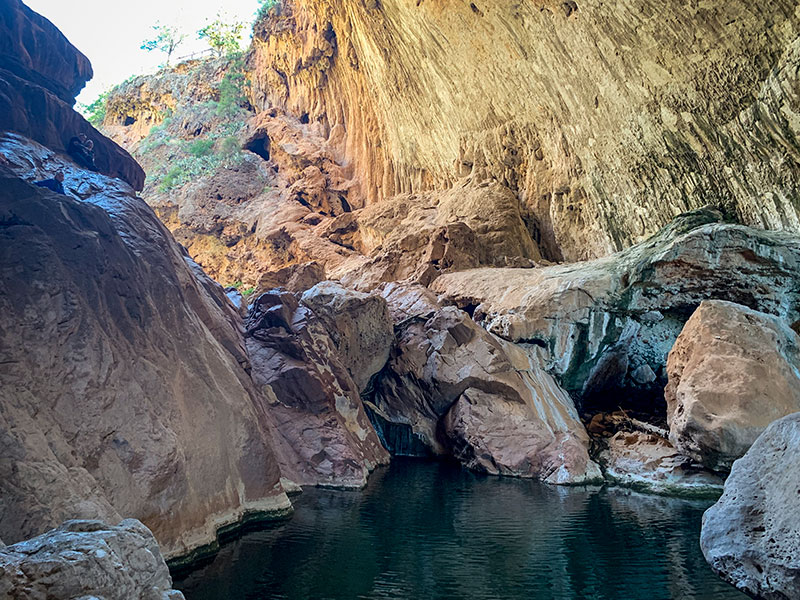
Hike a little bit off of the beaten path and check out the caves situated along the creek and underneath the bridge. The crevasses in the rocks were likely formed around the same time as the natural bridge by the sediment deposits getting eroded away by rain water running through the cracks in the sand and limestone.
In 1877, a prospector named David Gowan was the first person to discover the Tonto Natural Bridge. He stumbled upon it while being fleeing from Apache Native Americans who were chasing him because he was looking for gold on their land. When Gowan came to the bridge, he hid in one of the caves for several days until the pursuers gave up the chase.
Experience the thrill of what Gowan must have felt as he made these caves his home for a few days as a fugitive.
TIP
Be careful as you enter these caves, as some critters may call them their home. Warn your children about the possibility of snakes and other animals slumbering inside.7. Help Your Kids Become Junior Rangers
Help your kids (ages 6-12) become Junior Rangers by helping them do activities that will teach them how to take care of the beautiful planet we live on and how to appreciate the rarity of the Tonto Natural Bridge.
The first step to helping your children earn their Junior Ranger badge is by downloading this warm up Junior Ranger activity page. This is a perfect activity for the car ride up to Tonto Natural Bridge, or to be done beforehand.
When you arrive at the state park, go to the park office and talk to the ranger there about getting your kids the Junior Ranger activity booklets. During your trip to the park, the kids will need to complete the booklet and present it to a park ranger in order to receive their Junior Ranger badge. After they earn it, watch your kids wear it with pride because they helped make a difference.
Check out the Tonto Natural Bridge website for more information.
8. Search for Crawfish
Pine Creek slowly bubbles and pools into ponds as it meanders through the mountains and under the natural bridge. In these small ponds there are often crawfish laying on the rocks just under the surface of the water.
Both kids and adults alike will enjoy hunting for these small crustacean creatures. Put your fishing skills to the test by bringing an uncooked hot dog to break into pieces and put on a string to see if you can catch one. Crawfish are an invasive species in Arizona, so feel free to cook them and eat them too.
9. Take the Pine Creek Trail
If you want a longer hike, take the Pine Creek trail. This path is a little bit longer, but you get to walk alongside the creek and its small falls for almost half a mile before getting to the main attraction, the natural bridge.
Along this trail there are more opportunities to see wildlife because it is typically less traversed than the more popular Anne Marie trail which is significantly shorter. For a change in scenery, you could take one trail to the bridge and another trail out.
10. Go Swimming
Swimming is a no-no underneath the natural bridge, but it is allowed farther downstream in Pine Creek. This can be a nice way to cool off after a warm, sweat-inspiring hike up and down the hills around the state park.
To find the swimming areas, follow the creek through the bridge from the Anne Marie trail and continue past the observation deck. UPDATE AUGUST 2019: The observation deck area is closed, so it may be hard to get to the swimming areas until it opens again.
Be careful in the creek, because the smooth rocks can be very slippery and there is no lifeguard to help if someone falls or needs rescuing.
Map of Tonto Natural Bridge State Park
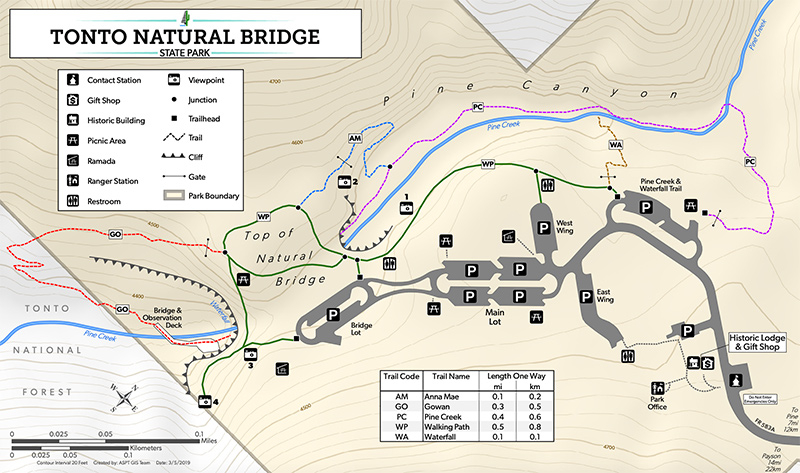
Tips When Visiting Tonto Natural Bridge
1. Take it Slow
You will be out and surrounded by Arizona’s natural beauty at its finest. Stop and take a moment to soak it all in, there’s no rush! It will also be a lot cooler than the valley heat of Phoenix during the summer, so enjoy it.
2. Be There When It Opens
The best time to visit the natural bridge is right when it opens.
The park is popular during the summer months because people want to escape the heat of the Phoenix Valley. It can get very busy, especially on the weekends. You will also get better photos without other people accidentally photobombing you, and the weather is cooler because the sun isn’t as high.
From May to September the state park opens at 9:00am. Check the website for information on park hours during other times of the year.
3. Follow the Arrows
Watch for arrows spray painted or screwed into the rocks. They’re occasionally hard to see, but they show you the easiest path to and through the bridge.
Trust me, I missed a few of these markers and almost ended up taking the long and slippery plunge into the lake.
4. Park at the South Lot
If you’re wondering where to park at Tonto Natural Bridge State Park, this is for you.
For the shortest walking distance, park at the south parking lot (the farthest from the entrance). It is much closer to the Natural Bridge, and it is within 500 feet of the Anne Marie trail which leads quickly down to Pine Creek.
5. Bring a Backpack
Bring a backpack to improve the quality of your hike. Not only will it be easier to carry more water, snacks, and other amenities, but it will give you free use of both of your hands as you clamber up and down the slippery rocks.
6. Avoid the Bathrooms if You Can
The restrooms at Tonto Natural Bridge are nothing more than glorified porta-potties. In other words, they are not great. For an all around better bathroom experience, make a stop at a restaurant or gas station in Payson before coming.
7. Bring Sunscreen
Remember as you hike that you’ll be close to 5000 feet elevation and almost assuredly enjoying clear skies. Sunscreen is a must.
8. Bring Cash
You can pay the park entrance fee with cash or credit card. Using cash, however, will save you a few minutes, as you can pay the Park Ranger at the gate with cash. Credit card payments must be made inside the Gift Shop, requiring you to park and go inside.
9. Wear Shoes with Traction
Underneath the bridge is where you’ll find all the glorious scenery. However, the walls are steep and the rocky paths are slick. Wearing shoes that give you a little extra grip will ensure a safer and more comfortable hike.
10. Support Your Ankles
In addition to wearing shoes with good traction, I also recommend hiking boots with ankle support. The paths down in the bridge are up and down over loose rocks or slick inclines. Turning an ankle is a real threat as you make your way through all the cracks and crevices.
Facts and History about Tonto Natural Bridge
How Long Does the Hike Take?
The hike itself is only about half a mile. If you want to take it slow and admire the grandeur of the natural bridge (recommended), then allow an hour and a half to two hours to explore.
What is the Mogollon Rim?
(If you already forgot, much like I did, it’s pronounced “muggy-own”)
The Mogollon Rim is a 200 mile-long escarpment, steep cliffs that are caused by tectonic movement that create a distinction between two relatively flat areas. This creates a sort of “rim” to the valley that is the beginning of the Colorado Plateau.
The Rim stretches nearly to New Mexico, and the top portion is about 3,000 feet higher in elevation than the areas to the south of it. The summer weather is fairly warm, and winters are mild, sometimes getting a little bit of snow.
The Largest Natural Travertine Bridge in the World
Travertine is a type of sediment that is commonly found in natural mineral springs. These particles are deposited by the spring when the water evaporates and it forms into a thin layer of rock. More and more sediment is deposited and it eventually forms into large rock structures.
The Tonto Natural Bridge was formed in this way, with layers of particles being deposited to form a massive land bridge. This process did not happen quickly, it took thousands of years for the natural bridge to be as large as it is now. As far as scientists and geologists know, this is the largest natural travertine bridge in the world.
Elevation of the Tonto Natural Bridge
The elevation of the Tonto Natural Bridge is 4,600 feet above sea level compared to Phoenix which is 1,000 feet in elevation.
Is there Camping at Tonto Natural Bridge?
There are no campgrounds in Tonto Natural Bridge State Park. Nearby in the Mogollon Rim area, there are many opportunities to go camping such as the nearby Christopher Creek campground. Look here for more information on camping at Tonto Natural Bridge.
Weather at Tonto Natural Bridge
The weather at Tonto Natural Bridge is very similar to the weather in Payson, Arizona. Here is the average Payson temperatures by month (High / Low Fahrenheit Source)
- January – 54° / 25°
- February – 57° / 28°
- March – 63° / 31°
- April – 70° / 36°
- May – 79° / 43°
- June – 90° / 51°
- July – 92° / 59°
- August – 89° / 59°
- September – 85° / 52°
- October – 74° / 41°
- November – 62° / 31°
- December – 54° / 25°
Tonto Natural Bridge Packing List
The Tonto Natural Bridge is in the Mogollon Rim region of the state of Arizona. This means that during the summer the weather is usually dry, warm, and sunny. It is important to bring water and sunscreen if doing this hike during the summertime.
Hiking boots are strongly recommended because they offer ankle support when navigating around and through the uneven rocks, cracks, and slick stones. Another important aspect of whatever footwear you bring is it should have traction to grip the smooth rock faces.
- Water
- Sunscreen
- Backpack / fanny pack / knapsack
- Snacks
- Closed-toed shoes with traction (something with ankle support is recommended because of the nooks and crannies that you step in)
Estimated Cost of Tonto Natural Bridge
The Tonto Natural Bridge State Park is fairly cheap to get into. Admission is $7.00 per adult (14 years and up), $4.00 for youth from 6 to 13 years old, and free for children under the age of 6.
Other costs to consider are the price of gas to drive to the park, and the cost of food if you will be bringing food in, eating in nearby Payson, or returning home to eat.
Breakdown of Tonto Natural Bridge Costs
- Admission:
- $6.00 per adult (14+)
- $4.00 per youth (6-13)
- Free for children (6 and under)
- Transportation: Varies depending upon the efficiency of vehicle and the distance traveled to get there. Expect about $10 to $30 for gas round trip.
- Food: Anywhere from $0 (not eating until you get home) to $20 per person (going out to eat in Payson, Arizona).
